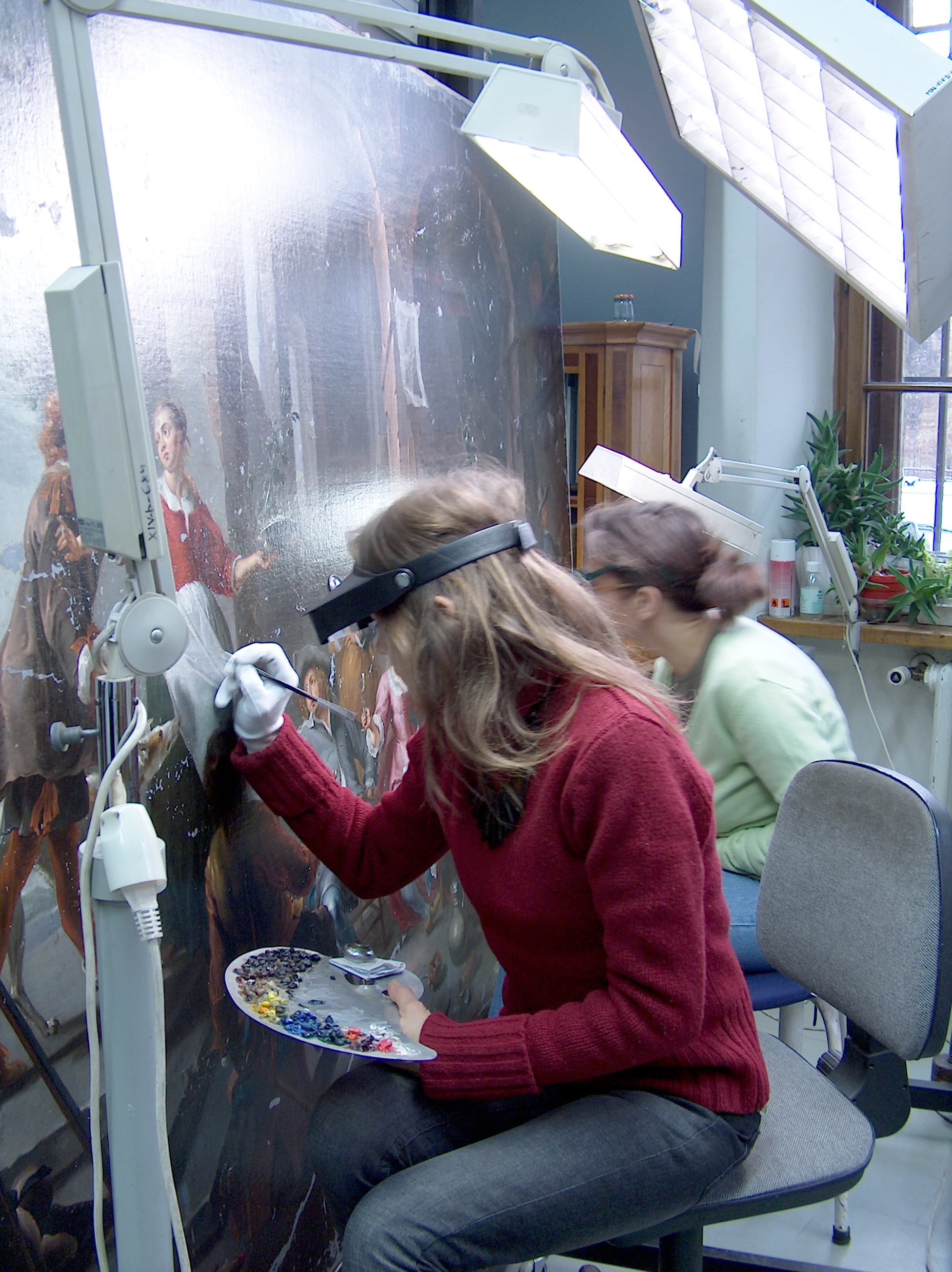
Conservator-restorer
A conservator-restorer is a professional responsible for the preservation of artistic and cultural artifacts, also known as cultural heritage.[1] Conservators possess the expertise to preserve cultural heritage in a way that retains the integrity of the object, building or site, including its historical significance, context and aesthetic or visual aspects.[2] This kind of preservation is done by analyzing and assessing the condition of cultural property, understanding processes and evidence of deterioration, planning collections care or site management strategies that prevent damage, carrying out conservation treatments, and conducting research.[3] A conservator's job is to ensure that the objects in a museum's collection are kept in the best possible condition, as well as to serve the museum's mission to bring art before the public.[4]
Main article: Conservation-restoration of cultural heritageConservation and restoration[edit]
Essentially, the term "conservation" refers to a manner of care or treatment that repairs damage and also takes action to prevent or slow down further deterioration of an object.[5] The term "restoration" refers to a manner of care or treatment in which the goal is to bring an object back to its original appearance or function.[5] "Restoration" can be part of the care and treatment of an object and is a subset of the umbrella term "conservation".[5] Both terms come into play when it comes to the treatment and care of all cultural heritage.
Education and training[edit]
Undergraduate and graduate education[edit]
Conservators can receive training through apprenticeships, internships and graduate programs. In order to be accepted into a graduate program in the United States, they will need to fulfill some undergraduate prerequisites. This includes undergraduate coursework in science, the humanities (art history, anthropology, and archaeology), and studio art.[3] Some graduate programs may also require internship, volunteer, apprenticeship, or paid conservation experience.[3] Many may also require a personal interview where candidates are asked to present a portfolio of art and conservation project work that demonstrates manual dexterity and familiarity with techniques and materials.[3] Graduate programs generally require two to four years of study, which can also include a full-time internship in the final year where students work under the guidance of experienced conservators.[3] There are also a limited number of Ph.D. programs for advanced study in conservation.[3] Conservation-related programs are described on the websites of the AIC,[8] the National Council for Preservation Education (NCPE),[9] and the Society of American Archivists (SAA).[10]
Post-graduate fellowships[edit]
Post-graduate fellowships have also been cited as valuable experiences in their professional development.[3] These fellowships provide intensive research, practice, and exposure to diverse professional staff or significant collections.[3] A few institutions that offer fellowships include the Getty Foundation,[11] the Smithsonian's Museum Conservation Institute,[12] and the Straus Center of Harvard Art Museums.[13]
Continued professional development[edit]
The specialty of conservation is ever-changing and evolving, which means that practicing conservators must stay up-to-date of advances in technology and methodology.[3] Conservators usually expand their knowledge through reading publications, attending professional meetings, and enrolling in short-term workshops or courses.[3] AIC offers many workshops, conferences, and online courses and tutorials.[14] Conservation OnLine (CoOL) also offers resources for conservation professionals.[15]
Some conservators specialize in a particular material or group of objects, such as archaeology, ceramics and glass, furniture and wood, gilding and decorative surfaces, historic interiors, metals, paintings, paper and books, photographic materials, stained glass, stone and wall paintings, textiles, sculptures, architecture, time-based art and new media.[3][7]
Ethics[edit]
The primary goal for conservators and restorers is the preservation of cultural property. In order to achieve this goal, conservators abide by a code of ethics and guidelines that establish the principles that guide conservation professionals and others who are involved in the care of cultural property. An example of a code of ethics and guidelines for practice were created by the American Institute for Conservation of Historic and Artistic Works (AIC).[16] One of the most important principles in a conservator's code of ethics is that treatments should be reversible, which means that one must be able to undo any treatment in the future.[4] Conservators strive to only minimize interventions and not completely alter an object during restoration. Conservation focuses on the material aspects of art, and respect for original materials remains a crucial element of the field's ethics.[4]